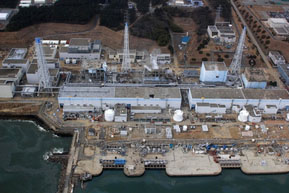Tepco Reports Second Deadly Radiation Reading at Fukushima Nuclear Plant
Fri Sep 16, 2011
By MARK DUNPHY
Irish Weather Online

Damaged Fukushima Nuclear Plant
Radioactive Substances May Return To Japanese Coast In 20-30 Years
A new study shows radioactive substances which leaked into the sea after March’s Fukushima crisis could return to Japanese coasts in 20 to 30 years, local media reported on Friday.
The research investigation was carried out by the Meteorological Research Institute and the Central Research Institute of Electric Power Industry, indicating that the leaked radioactive cesium is likely to circulate through the northern Pacific Ocean in a clockwise pattern before returning to Japan’s coast line in two or three decades, the Kyodo news agency reported.
The study also showed that the estimated amount of radioactive cesium-137 which was directly released into the sea from March until the end of May was about 3,500 terabecquerels. It also estimated that about 10,000 terabecquerels of additional cesium-137 dropped into the ocean after it was released into the air.
Ocean currents are expected to disperse the radioactive substance eastward and into the northern Pacific Ocean. According to the research, the current from around the Philippines would carry the cesium back to the country after previously shifting southwestward.
With an estimated half life of about 30 years, studies have shown that cesium-137 can cause cancer as it accumulates in the body’s muscle system once inside the human body.
High levels of radioactive cesium have also been found in Japanese beef. The latest case occurred last week in the country’s Iwate Prefecture, located in the Tohoku region of Honshu Island, as tests showed that two of eight beef cattle being shipped exceeded the government’s allowable limit of 500 becquerels of cesium per kilogram (2.25 pounds).
In July, radioactive cesium was found in straw fed to cattle at a farm in Minamisoma, Fukushima Prefecture with an average of 75,000 becquerels of the radioactive isotope per kilogram (2.25 pounds), which is about 56 times the allowable limit.
Japan has been facing an ongoing nuclear crisis since the Fukushima Daiichi nuclear power plant was severely damaged on March 11 when a 9.0-magnitude earthquake and a subsequent tsunami devastated the country. The disaster disabled the cooling systems of the plant, and radioactive elements leaked into the sea and were later found in water, air and food products in some parts of Japan.
At least 23,482 people were killed, while 8,069 people remain missing. There are still more than 88,000 people who are staying in shelters in 21 prefectures around Japan.
This document contains copyrighted material whose use has not been specifically authorized by the copyright owner. SEED Coalition is making this article available in our efforts to advance understanding of ecological sustainability, human rights, economic democracy and social justice issues. We believe that this constitutes a "fair use" of the copyrighted material as provided for in section 107 of the US Copyright Law. If you wish to use this copyrighted material for purposes of your own that go beyond "fair use", you must obtain permission from the copyright owner.


